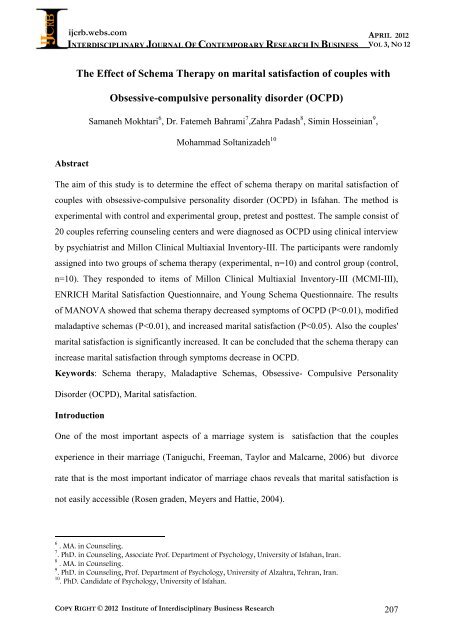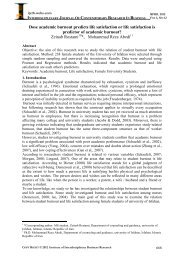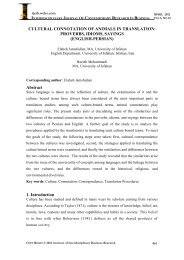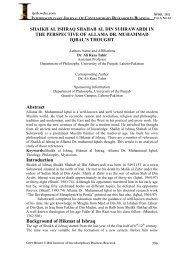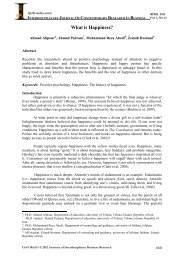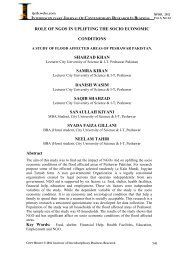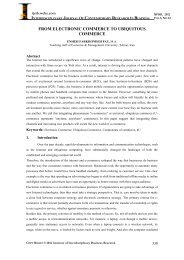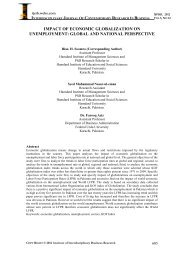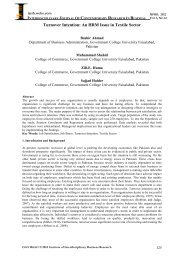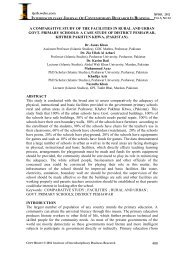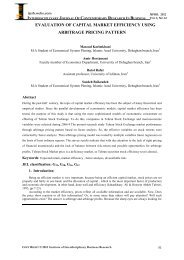The Effect of Schema Therapy on marital satisfaction - journal ...
The Effect of Schema Therapy on marital satisfaction - journal ...
The Effect of Schema Therapy on marital satisfaction - journal ...
Create successful ePaper yourself
Turn your PDF publications into a flip-book with our unique Google optimized e-Paper software.
ijcrb.webs.com<br />
INTERDISCIPLINARY JOURNAL OF CONTEMPORARY RESEARCH IN BUSINESS<br />
Abstract<br />
COPY RIGHT © 2012 Institute <str<strong>on</strong>g>of</str<strong>on</strong>g> Interdisciplinary Business Research<br />
APRIL 2012<br />
VOL 3, NO 12<br />
<str<strong>on</strong>g>The</str<strong>on</strong>g> <str<strong>on</strong>g>Effect</str<strong>on</strong>g> <str<strong>on</strong>g>of</str<strong>on</strong>g> <str<strong>on</strong>g>Schema</str<strong>on</strong>g> <str<strong>on</strong>g>The</str<strong>on</strong>g>rapy <strong>on</strong> <strong>marital</strong> satisfacti<strong>on</strong> <str<strong>on</strong>g>of</str<strong>on</strong>g> couples with<br />
Obsessive-compulsive pers<strong>on</strong>ality disorder (OCPD)<br />
Samaneh Mokhtari 6 , Dr. Fatemeh Bahrami 7 ,Zahra Padash 8 , Simin Hosseinian 9 ,<br />
Mohammad Soltanizadeh 10<br />
<str<strong>on</strong>g>The</str<strong>on</strong>g> aim <str<strong>on</strong>g>of</str<strong>on</strong>g> this study is to determine the effect <str<strong>on</strong>g>of</str<strong>on</strong>g> schema therapy <strong>on</strong> <strong>marital</strong> satisfacti<strong>on</strong> <str<strong>on</strong>g>of</str<strong>on</strong>g><br />
couples with obsessive-compulsive pers<strong>on</strong>ality disorder (OCPD) in Isfahan. <str<strong>on</strong>g>The</str<strong>on</strong>g> method is<br />
experimental with c<strong>on</strong>trol and experimental group, pretest and posttest. <str<strong>on</strong>g>The</str<strong>on</strong>g> sample c<strong>on</strong>sist <str<strong>on</strong>g>of</str<strong>on</strong>g><br />
20 couples referring counseling centers and were diagnosed as OCPD using clinical interview<br />
by psychiatrist and Mill<strong>on</strong> Clinical Multiaxial Inventory-III. <str<strong>on</strong>g>The</str<strong>on</strong>g> participants were randomly<br />
assigned into two groups <str<strong>on</strong>g>of</str<strong>on</strong>g> schema therapy (experimental, n=10) and c<strong>on</strong>trol group (c<strong>on</strong>trol,<br />
n=10). <str<strong>on</strong>g>The</str<strong>on</strong>g>y resp<strong>on</strong>ded to items <str<strong>on</strong>g>of</str<strong>on</strong>g> Mill<strong>on</strong> Clinical Multiaxial Inventory-III (MCMI-III),<br />
ENRICH Marital Satisfacti<strong>on</strong> Questi<strong>on</strong>naire, and Young <str<strong>on</strong>g>Schema</str<strong>on</strong>g> Questi<strong>on</strong>naire. <str<strong>on</strong>g>The</str<strong>on</strong>g> results<br />
<str<strong>on</strong>g>of</str<strong>on</strong>g> MANOVA showed that schema therapy decreased symptoms <str<strong>on</strong>g>of</str<strong>on</strong>g> OCPD (P
ijcrb.webs.com<br />
INTERDISCIPLINARY JOURNAL OF CONTEMPORARY RESEARCH IN BUSINESS<br />
COPY RIGHT © 2012 Institute <str<strong>on</strong>g>of</str<strong>on</strong>g> Interdisciplinary Business Research<br />
APRIL 2012<br />
VOL 3, NO 12<br />
Marriage satisfacti<strong>on</strong> results from happiness and a good adjustment between the husband<br />
and wife about different aspects <str<strong>on</strong>g>of</str<strong>on</strong>g> life and it guarantees the strength <str<strong>on</strong>g>of</str<strong>on</strong>g> the family and a<br />
healthy relati<strong>on</strong>ship (Asgari, 2001).<br />
It seems to be two main theoretical approaches related to effective factors <strong>on</strong> <strong>marital</strong><br />
satisfacti<strong>on</strong>. In psychoanalytical theories, intrapers<strong>on</strong>al factors and in behavioral theories<br />
interpers<strong>on</strong>al factors are regarded.<br />
As a whole it can be said that factors such as age, educati<strong>on</strong>, children, marriage durati<strong>on</strong>,<br />
couples' cooperati<strong>on</strong>, interpers<strong>on</strong>al understanding, religious beliefs, financial matters, friends<br />
and relatives, sexual relati<strong>on</strong>ship, leisure time activities and housework, occupati<strong>on</strong>,<br />
interpers<strong>on</strong>al skills, intimacy and self expressi<strong>on</strong>, cognitive factors, pers<strong>on</strong>ality traits, mental<br />
disorders and psychological health are effective <strong>on</strong> <strong>marital</strong> satisfacti<strong>on</strong> (Nazari, 2008; Greef<br />
and Malherb, 2001, Bouchard, Sabounn, lussier& Villeneure, 2009).<br />
One factor that has an important effect <strong>on</strong> interpers<strong>on</strong>al relati<strong>on</strong>ship including couples is<br />
pers<strong>on</strong>ality pathology. Based <strong>on</strong> DSM-IV, a pers<strong>on</strong> with pers<strong>on</strong>ality disorders is noticeably<br />
destructive in two domains <str<strong>on</strong>g>of</str<strong>on</strong>g> pers<strong>on</strong>al and interpers<strong>on</strong>al functi<strong>on</strong>ing. Pers<strong>on</strong>al domain means<br />
that what the client's view is and therefore what are his/her purposes in life and how to follow<br />
them? Interpers<strong>on</strong>al domain emphasizes <strong>on</strong> whether s/he can understand other's view and<br />
relate with them. Although there has been not much research <strong>on</strong> the simultaneity relati<strong>on</strong>ship<br />
between pers<strong>on</strong>al pathology and <strong>marital</strong> dysfuncti<strong>on</strong>, but South, Turkheimer and Oltmanns<br />
(2008) in a research <strong>on</strong> a sample <str<strong>on</strong>g>of</str<strong>on</strong>g> 82 married couples showed that pers<strong>on</strong>ality disorder has<br />
had a significant correlati<strong>on</strong> with <strong>marital</strong> satisfacti<strong>on</strong>, verbal aggressi<strong>on</strong>, physical violence;<br />
and pers<strong>on</strong>ality disorder determines 25% to 45% <str<strong>on</strong>g>of</str<strong>on</strong>g> the variati<strong>on</strong> <str<strong>on</strong>g>of</str<strong>on</strong>g> <strong>marital</strong> adjustment. Since<br />
pers<strong>on</strong>ality disorder individuals have problems in interpers<strong>on</strong>al functi<strong>on</strong>ing, <str<strong>on</strong>g>The</str<strong>on</strong>g>y also have<br />
various problems in adjustment and <strong>marital</strong> satisfacti<strong>on</strong>.<br />
208
ijcrb.webs.com<br />
INTERDISCIPLINARY JOURNAL OF CONTEMPORARY RESEARCH IN BUSINESS<br />
COPY RIGHT © 2012 Institute <str<strong>on</strong>g>of</str<strong>on</strong>g> Interdisciplinary Business Research<br />
APRIL 2012<br />
VOL 3, NO 12<br />
One <str<strong>on</strong>g>of</str<strong>on</strong>g> the pers<strong>on</strong>ality disorders that is diagnosed by perfecti<strong>on</strong>ism, moodiness, and<br />
extreme orderliness is the obsessive-compulsive pers<strong>on</strong>ality disorder (OCPD). <str<strong>on</strong>g>The</str<strong>on</strong>g>se<br />
individuals have shortcomings in relati<strong>on</strong>ship patterns with their spouses, emoti<strong>on</strong>al<br />
expressi<strong>on</strong> and emoti<strong>on</strong>al limitati<strong>on</strong> and they are usually very formal, unemoti<strong>on</strong>al and moral<br />
(Rosenhan and Seligman, 1995). Since, intimate relati<strong>on</strong>ship, self expressi<strong>on</strong>, positive<br />
emoti<strong>on</strong>s and praising each other are the necessary factors for <strong>marital</strong> satisfacti<strong>on</strong>( M<strong>on</strong>roe,<br />
1990; Bouchard et al, 2009) obsessive-compulsive pers<strong>on</strong>ality disorder (OCPD) is c<strong>on</strong>sidered<br />
as <strong>on</strong>e <str<strong>on</strong>g>of</str<strong>on</strong>g> the important effective factors <strong>on</strong> <strong>marital</strong> dissatisfacti<strong>on</strong>.<br />
For <strong>marital</strong> satisfacti<strong>on</strong> and adjustment, it is necessary to develop a c<strong>on</strong>stant effective<br />
relati<strong>on</strong>ship and for this purpose, the couple needs to share thoughts and emoti<strong>on</strong>s and to give<br />
positive reacti<strong>on</strong>s and gratitude to each other (Siliman, 2001). And at the same time poor<br />
interpers<strong>on</strong>al skills, unclear or c<strong>on</strong>diti<strong>on</strong>al relati<strong>on</strong>ships, fault seeking and c<strong>on</strong>stant blaming,<br />
mind-reading and defiance, showing negative emoti<strong>on</strong>s repeatedly and <strong>on</strong> the other hand<br />
having little positive emoti<strong>on</strong>s, having negative thoughts and cognitive distorti<strong>on</strong>s could be<br />
lead to <strong>marital</strong> maladjustment and dissatisfacti<strong>on</strong> (Gottman, 1993; Nak<strong>on</strong>ezny,Shull and<br />
Rogers,1995).<br />
People who suffered from OCPD, have behavioral and emoti<strong>on</strong>al patterns such as<br />
repressing their own emoti<strong>on</strong>s, prejudice and stiffness in behavior, and over c<strong>on</strong>trol <strong>on</strong> their<br />
own and other people's behavior. <str<strong>on</strong>g>The</str<strong>on</strong>g>se people have limited feelings and c<strong>on</strong>trol <strong>on</strong> their own<br />
emoti<strong>on</strong>s and d<strong>on</strong>'t usually express them. <str<strong>on</strong>g>The</str<strong>on</strong>g>y also repress their own anger and hate (Mill<strong>on</strong>,<br />
Grossman, Mill<strong>on</strong>, Meagher and Ramnath, 2004). Regarding to the features <str<strong>on</strong>g>of</str<strong>on</strong>g> the obsessive-<br />
compulsive pers<strong>on</strong>ality disorder (OCPD), this special patterns <str<strong>on</strong>g>of</str<strong>on</strong>g> expressing emoti<strong>on</strong>s and<br />
behavior cause to relati<strong>on</strong>ship problems and can lead to mental separati<strong>on</strong> (Gottman, 1994).<br />
In the developmental history <str<strong>on</strong>g>of</str<strong>on</strong>g> these individuals being forced to do what other people<br />
impose is very comm<strong>on</strong> (Choca and Van Denberg, 1997). <str<strong>on</strong>g>The</str<strong>on</strong>g> parenting styles that most<br />
209
ijcrb.webs.com<br />
INTERDISCIPLINARY JOURNAL OF CONTEMPORARY RESEARCH IN BUSINESS<br />
COPY RIGHT © 2012 Institute <str<strong>on</strong>g>of</str<strong>on</strong>g> Interdisciplinary Business Research<br />
APRIL 2012<br />
VOL 3, NO 12<br />
notably associated with the disorder are c<strong>on</strong>sistently, strict, authoritarian, and over c<strong>on</strong>trolling<br />
styles. In their childhood, these children were likely taught to be overly resp<strong>on</strong>sible for their<br />
behaviors, and trained to feel shameful and worthless if not compliant. Sperry and Carls<strong>on</strong><br />
(1996) hypothesized that ―the parental injuncti<strong>on</strong> to which they were most likely exposed was<br />
‗You must do and be better to be worthwhile‘‖ (Laksman, 2007).<br />
Cogniti<strong>on</strong> approaches c<strong>on</strong>sider the role <str<strong>on</strong>g>of</str<strong>on</strong>g> irrati<strong>on</strong>al core beliefs or maladaptive schemas<br />
as important factor in the forming <str<strong>on</strong>g>of</str<strong>on</strong>g> obsessive compulsive pers<strong>on</strong>ality disorder (Mill<strong>on</strong>,<br />
Grossman, Mill<strong>on</strong>, Meagher and Ramnath, 2004). <str<strong>on</strong>g>The</str<strong>on</strong>g> obsessive compulsive pers<strong>on</strong>ality<br />
disorder (OCPD) correlate to dysfuncti<strong>on</strong>al cogniti<strong>on</strong> schemas towards resp<strong>on</strong>sibility and its<br />
thoughts deal with schemas such as blame, punishment, guilt and shame. <str<strong>on</strong>g>The</str<strong>on</strong>g>se schemas are<br />
predefined in their memories that <str<strong>on</strong>g>of</str<strong>on</strong>g>ten impose their structures to the new informati<strong>on</strong><br />
(Rheaume, Ladouceur, Freest<strong>on</strong>e and Lerarte, 1995). <str<strong>on</strong>g>The</str<strong>on</strong>g>y also have low desire to healthy<br />
behavioral resp<strong>on</strong>ses so that they experience impulsive behaviors and high worry( Arntz,<br />
Weertman, Salt, 2001).<br />
<str<strong>on</strong>g>The</str<strong>on</strong>g>re are different approaches c<strong>on</strong>cerning how to cure people suffering from pers<strong>on</strong>ality<br />
disorders including obsessive compulsive pers<strong>on</strong>ality disorder (OCPD). To name just a few<br />
we can menti<strong>on</strong>: Psychoanalyses based <strong>on</strong> transference psychotherapy (Kernberg and<br />
Klarkin, 1999), behavioral psychotherapies such as Dialectical Behavior therapy (Linehan,<br />
1993) and also treatments based <strong>on</strong> cognitive approaches such as cognitive therapy (Beck and<br />
Freeman, 1990; Freeman and Fusco, 2004), rati<strong>on</strong>al-emoti<strong>on</strong>al therapy (Ellis,2001),<br />
c<strong>on</strong>trastive-cognitive therapy (Sharf,2002), cogniti<strong>on</strong> Revoluti<strong>on</strong>al therapy (Lyoti,2002;<br />
Oldham, Gabbard and Gain, 2001; Arntz, Klokman and Siesweda, 2005) and also medicine<br />
therapy (Joyice, 2003).<br />
210
ijcrb.webs.com<br />
INTERDISCIPLINARY JOURNAL OF CONTEMPORARY RESEARCH IN BUSINESS<br />
COPY RIGHT © 2012 Institute <str<strong>on</strong>g>of</str<strong>on</strong>g> Interdisciplinary Business Research<br />
APRIL 2012<br />
VOL 3, NO 12<br />
One <str<strong>on</strong>g>of</str<strong>on</strong>g> the various types <str<strong>on</strong>g>of</str<strong>on</strong>g> cognitive therapy that is actually the developed form <str<strong>on</strong>g>of</str<strong>on</strong>g> the<br />
traditi<strong>on</strong>al cognitive behavioral therapy and focuses more <strong>on</strong> relati<strong>on</strong>ship therapy, emoti<strong>on</strong>al<br />
experiences and early life experiences is the schema focused therapy (Young, 1999).<br />
<str<strong>on</strong>g>Schema</str<strong>on</strong>g> therapy is based <strong>on</strong> a cognitive–integrative c<strong>on</strong>ceptualizati<strong>on</strong> <str<strong>on</strong>g>of</str<strong>on</strong>g> pers<strong>on</strong>ality<br />
disorders using a broader and more eclectic approaches than the usual cognitive therapy<br />
approaches, integrating various theoretical formulati<strong>on</strong>s (Young, 1994; Arntz, 1994; Young,<br />
Klosko, & Weishaar, 2003; quoting from Nordhal and Nyster, 2005).<br />
A schema c<strong>on</strong>diti<strong>on</strong> is an organizati<strong>on</strong>al manner <str<strong>on</strong>g>of</str<strong>on</strong>g> thinking, feeling and behaving based<br />
<strong>on</strong> a group <str<strong>on</strong>g>of</str<strong>on</strong>g> schemas and each group <str<strong>on</strong>g>of</str<strong>on</strong>g> schema c<strong>on</strong>diti<strong>on</strong>s is relatively independent <str<strong>on</strong>g>of</str<strong>on</strong>g> the<br />
others (Arntz, Klokman and Siesweda, 2005). Early Maladaptive <str<strong>on</strong>g>Schema</str<strong>on</strong>g>s (EMS) are broad,<br />
pervasive themes or patterns that develop during childhood or adolescence and grown into<br />
older age and are inefficient to a high degree (Young, 1999).<br />
<str<strong>on</strong>g>Schema</str<strong>on</strong>g> therapy combines techniques from cognitive, behavioral, psychoanalytical,<br />
existentialism and humanistic therapies. Although the basic frame in this therapy is based <strong>on</strong><br />
cogniti<strong>on</strong>, it has been affected a lot by object relati<strong>on</strong>s and attachment approaches. Unlike<br />
different types <str<strong>on</strong>g>of</str<strong>on</strong>g> cognitive therapies that focus <strong>on</strong> the present state <str<strong>on</strong>g>of</str<strong>on</strong>g> the pers<strong>on</strong>, schema<br />
therapy approach focuses <strong>on</strong> self-destroying thoughts, feelings and behaviors that were<br />
developed in childhood and are repeated in his life (Bernstain, 2005;quoting from<br />
Strack,2005) and is developed for patients resistant to treatment such as pers<strong>on</strong>ality disorders,<br />
chr<strong>on</strong>ic depressi<strong>on</strong>s and anxiety disorders. <str<strong>on</strong>g>Schema</str<strong>on</strong>g> therapy has four main interventi<strong>on</strong>s,<br />
including:1) Cognitive Interventi<strong>on</strong>s,2) Experiential Interventi<strong>on</strong>s,3) Interpers<strong>on</strong>al<br />
Interventi<strong>on</strong>s,4) Behavioral Interventi<strong>on</strong>s. <str<strong>on</strong>g>Schema</str<strong>on</strong>g> therapy procedure is divided into two<br />
main phases: a) C<strong>on</strong>ceptualizati<strong>on</strong> and Evaluati<strong>on</strong>, b) Change schema (Young, Klosko and<br />
Weishaar, 2003).<br />
211
ijcrb.webs.com<br />
INTERDISCIPLINARY JOURNAL OF CONTEMPORARY RESEARCH IN BUSINESS<br />
COPY RIGHT © 2012 Institute <str<strong>on</strong>g>of</str<strong>on</strong>g> Interdisciplinary Business Research<br />
APRIL 2012<br />
VOL 3, NO 12<br />
<str<strong>on</strong>g>The</str<strong>on</strong>g> several researches c<strong>on</strong>cerning the efficiency <str<strong>on</strong>g>of</str<strong>on</strong>g> this schema therapy have been d<strong>on</strong>e.<br />
Although these research d<strong>on</strong>'t study the efficiency <str<strong>on</strong>g>of</str<strong>on</strong>g> the schema therapy for the obsessive<br />
compulsive pers<strong>on</strong>ality disorder, but they can be used as a pro<str<strong>on</strong>g>of</str<strong>on</strong>g> for its effectiveness <strong>on</strong><br />
pers<strong>on</strong>ality disorders. Nordhal and Nyster (2005) have reported schema therapy as effective<br />
<strong>on</strong> reducing the symptoms <str<strong>on</strong>g>of</str<strong>on</strong>g> borderline pers<strong>on</strong>ality disorders. Nordhal, Holth and Shaugum<br />
(2005) also, did a study about the effectiveness <str<strong>on</strong>g>of</str<strong>on</strong>g> moderating <str<strong>on</strong>g>of</str<strong>on</strong>g> schema <strong>on</strong> reducing the<br />
symptoms <str<strong>on</strong>g>of</str<strong>on</strong>g> pers<strong>on</strong>ality disorder. <str<strong>on</strong>g>The</str<strong>on</strong>g>y also perceived that moderating <str<strong>on</strong>g>of</str<strong>on</strong>g> schema can predict<br />
the amount <str<strong>on</strong>g>of</str<strong>on</strong>g> the reducti<strong>on</strong> <str<strong>on</strong>g>of</str<strong>on</strong>g> symptoms in this type <str<strong>on</strong>g>of</str<strong>on</strong>g> disorders. <str<strong>on</strong>g>The</str<strong>on</strong>g> results <str<strong>on</strong>g>of</str<strong>on</strong>g> the research<br />
d<strong>on</strong>e by Kellogg and Young (2006), Farrell, Shaw and Webber (2009), and Nadort, (et al,<br />
2009), are also c<strong>on</strong>sistent <strong>on</strong> the functi<strong>on</strong>al <str<strong>on</strong>g>of</str<strong>on</strong>g> schema therapy. <str<strong>on</strong>g>The</str<strong>on</strong>g>re have been few<br />
researches about <strong>marital</strong> satisfacti<strong>on</strong> and its c<strong>on</strong>necti<strong>on</strong> with pers<strong>on</strong>ality disorder especially<br />
the obsessive compulsive pers<strong>on</strong>ality disorder and the early maladaptive schemas. In<br />
Gottman's research (1993), it was showed that expressing emoti<strong>on</strong>s has an important role <strong>on</strong><br />
couple closeness (Zadhoosh, 2007). Whisman(1999) showed in a research d<strong>on</strong>e <strong>on</strong> a sample<br />
<str<strong>on</strong>g>of</str<strong>on</strong>g> 2538 married couples that <strong>marital</strong> dissatisfacti<strong>on</strong> can be related to any kind <str<strong>on</strong>g>of</str<strong>on</strong>g> mental<br />
disorder. South, Turkheimer and Oltmanns (2008), also showed in a research <strong>on</strong> a sample <str<strong>on</strong>g>of</str<strong>on</strong>g><br />
82 married couples that there is a negative relati<strong>on</strong> between <strong>marital</strong> satisfacti<strong>on</strong> and<br />
pers<strong>on</strong>ality disorders. Shafiee, ( et al, 2006), also perceived in a sample <str<strong>on</strong>g>of</str<strong>on</strong>g> 245 married<br />
couples that <strong>marital</strong> satisfacti<strong>on</strong> has a negative relati<strong>on</strong>ship with depressi<strong>on</strong>, anxiety disorder<br />
and the obsessive compulsive disorder. Also in the study <str<strong>on</strong>g>of</str<strong>on</strong>g> Naderi (2007) it was denoted that<br />
c<strong>on</strong>cerning perfecti<strong>on</strong>ism and <strong>marital</strong> c<strong>on</strong>flicts there is a significant difference between the<br />
families who refer to family courts and normal families.<br />
According to literature and researches, <strong>on</strong>e <str<strong>on</strong>g>of</str<strong>on</strong>g> the important effective factors <strong>on</strong> <strong>marital</strong><br />
satisfacti<strong>on</strong> is a pers<strong>on</strong>ality disorder such as the obsessive compulsive pers<strong>on</strong>ality disorder<br />
and whereas the obsessive compulsive pers<strong>on</strong>ality disorder (OCPD) is known by<br />
212
ijcrb.webs.com<br />
INTERDISCIPLINARY JOURNAL OF CONTEMPORARY RESEARCH IN BUSINESS<br />
COPY RIGHT © 2012 Institute <str<strong>on</strong>g>of</str<strong>on</strong>g> Interdisciplinary Business Research<br />
APRIL 2012<br />
VOL 3, NO 12<br />
dysfuncti<strong>on</strong>al cognitive schemas, This research aimed to study the effects <str<strong>on</strong>g>of</str<strong>on</strong>g> schema therapy<br />
<strong>on</strong> <strong>marital</strong> satisfacti<strong>on</strong> in married couples suffering from OCPD, by correcting and changing<br />
the dysfuncti<strong>on</strong>al core beliefs or the early maladaptive schemas (EMS).<br />
Method<br />
Participants<br />
<str<strong>on</strong>g>The</str<strong>on</strong>g> participants who entered the study were 20 couples who referred themselves to Isfahan<br />
counseling centers. Age <str<strong>on</strong>g>of</str<strong>on</strong>g> participants ranged from 23 to 40 years (M=27.6, SD=5.1, years).<br />
Age <str<strong>on</strong>g>of</str<strong>on</strong>g> their partners ranged from 21 to 45 years (M=45, SD=29.6, years). Length <str<strong>on</strong>g>of</str<strong>on</strong>g><br />
marriage ranged from 1 year to 15 years (M=5.37, SD=4.04, years). Fifty percent <str<strong>on</strong>g>of</str<strong>on</strong>g> couples<br />
hadn't any child, 37.5 percent had <strong>on</strong>e child and 12.5 percent had two children.<br />
Procedures<br />
All the participants were randomly chosen from five counseling centers in Isfahan, using the<br />
cluster random sampling. <str<strong>on</strong>g>The</str<strong>on</strong>g> inviting poster was provided that informed clients about OCPD<br />
symptoms. Clients who c<strong>on</strong>sidered themselves as having the symptoms <str<strong>on</strong>g>of</str<strong>on</strong>g> the obsessive<br />
compulsive pers<strong>on</strong>ality disorder and perfecti<strong>on</strong>ist behavior and were willing to take part in<br />
this educati<strong>on</strong>al-treatment workshop were enrolled. <str<strong>on</strong>g>The</str<strong>on</strong>g>n, based <strong>on</strong> a diagnostic interview<br />
according to the DSM-IV-R standards by psychiatrist and using Mill<strong>on</strong> Clinical Multiaxial<br />
Inventory-III (MCMI-III), from am<strong>on</strong>g all the volunteers, a group <str<strong>on</strong>g>of</str<strong>on</strong>g> married couples who<br />
had the symptoms <str<strong>on</strong>g>of</str<strong>on</strong>g> the obsessive compulsive pers<strong>on</strong>ality disorder (OCPD) were chosen.<br />
<str<strong>on</strong>g>The</str<strong>on</strong>g>n, in a simple random sampling twenty people were recruited and were randomly<br />
assigned into two groups <str<strong>on</strong>g>of</str<strong>on</strong>g> experimental and c<strong>on</strong>trol. It is worth menti<strong>on</strong>ing that the<br />
c<strong>on</strong>diti<strong>on</strong> for entering <str<strong>on</strong>g>of</str<strong>on</strong>g> subjects was to be at least <str<strong>on</strong>g>of</str<strong>on</strong>g> 18 years age and to have at least<br />
diploma educati<strong>on</strong>al degree. Also excluding c<strong>on</strong>diti<strong>on</strong>s were, people who suffering from<br />
psychotic disorders or the patients has an acute, relatively severe, untreated Axis I disorder<br />
requiring immediate attenti<strong>on</strong> and the patient who is currently abusing alcohol or other drugs<br />
213
ijcrb.webs.com<br />
INTERDISCIPLINARY JOURNAL OF CONTEMPORARY RESEARCH IN BUSINESS<br />
COPY RIGHT © 2012 Institute <str<strong>on</strong>g>of</str<strong>on</strong>g> Interdisciplinary Business Research<br />
APRIL 2012<br />
VOL 3, NO 12<br />
at a moderate to severe level, and also, if their presenting problems to be situati<strong>on</strong>al or does<br />
not seem to be related to a life pattern or schema. <str<strong>on</strong>g>The</str<strong>on</strong>g> participants didn‘t know that they are<br />
in a research situati<strong>on</strong> while, the therapist knew. <str<strong>on</strong>g>The</str<strong>on</strong>g> y participated in 12 therapeutic sessi<strong>on</strong>s.<br />
<str<strong>on</strong>g>The</str<strong>on</strong>g> attriti<strong>on</strong> rate was zero. <str<strong>on</strong>g>The</str<strong>on</strong>g> people in waiting list participated in therapeutic sessi<strong>on</strong>s<br />
after the research. Due to follow treatment integrity the therapist was the pers<strong>on</strong> who planned<br />
the package <str<strong>on</strong>g>of</str<strong>on</strong>g> therapy. <str<strong>on</strong>g>The</str<strong>on</strong>g>re were no data reducti<strong>on</strong> and the participants‘ satisfacti<strong>on</strong> was<br />
assessed during the sessi<strong>on</strong>s <strong>on</strong> a c<strong>on</strong>tinuum form 0 (totally dissatisfied) to 100 (totally<br />
satisfied). <str<strong>on</strong>g>The</str<strong>on</strong>g> participants were informed that all <str<strong>on</strong>g>of</str<strong>on</strong>g> their informati<strong>on</strong> are secret.<br />
Measures<br />
<str<strong>on</strong>g>The</str<strong>on</strong>g> data attained using 3 questi<strong>on</strong>naires including as follow:<br />
1- <str<strong>on</strong>g>The</str<strong>on</strong>g> Mill<strong>on</strong> Clinical Multiaxial Inventory-III (MCMI-III, Mill<strong>on</strong> 1994) was used in<br />
order to study the problems and also the symptoms <str<strong>on</strong>g>of</str<strong>on</strong>g> the obsessive-compulsive<br />
pers<strong>on</strong>ality disorder at first. This is a self-report scale <str<strong>on</strong>g>of</str<strong>on</strong>g> 175 yes/no questi<strong>on</strong>s that<br />
evaluates 14 pers<strong>on</strong>ality clinical patterns and 10 clinical symptoms and has 4 validity<br />
scales. <str<strong>on</strong>g>The</str<strong>on</strong>g> scale number 7 in this questi<strong>on</strong>naire evaluates the obsessive-compulsive<br />
pers<strong>on</strong>ality disorder. In a research d<strong>on</strong>e by Sharifi (2002), the Cr<strong>on</strong>bach alpha<br />
coefficients alpha was <str<strong>on</strong>g>of</str<strong>on</strong>g> 0/85 to 0/97. <str<strong>on</strong>g>The</str<strong>on</strong>g> questi<strong>on</strong>naire also dem<strong>on</strong>strated good<br />
discriminate validity <strong>on</strong> all scales (Sharifi, 2002).<br />
2- <str<strong>on</strong>g>The</str<strong>on</strong>g> Enriching and Nurturing Relati<strong>on</strong>ship Issues, Communicati<strong>on</strong> and Happiness<br />
Questi<strong>on</strong>naire (ENRICH), has 115 items and is scored using the Likert scale. This<br />
questi<strong>on</strong>naire is made <str<strong>on</strong>g>of</str<strong>on</strong>g> 12 subscales. <str<strong>on</strong>g>The</str<strong>on</strong>g> first scale has 5 items and the others have<br />
10 items. <str<strong>on</strong>g>The</str<strong>on</strong>g> subscales are included: idealistic distorti<strong>on</strong>, <strong>marital</strong> satisfacti<strong>on</strong>,<br />
pers<strong>on</strong>ality issues, communicati<strong>on</strong>, c<strong>on</strong>flict resoluti<strong>on</strong>, financial management, leisure<br />
activities, sexual relati<strong>on</strong>ship, children and parenting, family and friends, equalitarian<br />
roles and religious orientati<strong>on</strong>. This questi<strong>on</strong>naire was measured according to Iranian<br />
214
ijcrb.webs.com<br />
INTERDISCIPLINARY JOURNAL OF CONTEMPORARY RESEARCH IN BUSINESS<br />
COPY RIGHT © 2012 Institute <str<strong>on</strong>g>of</str<strong>on</strong>g> Interdisciplinary Business Research<br />
APRIL 2012<br />
VOL 3, NO 12<br />
norms and its validity and reliability was approved by Asrar and Haghshenas (2005).<br />
In Mahdavian's research (1997), the reliability was 0.94 using the retesting method.<br />
3- <str<strong>on</strong>g>The</str<strong>on</strong>g> Young <str<strong>on</strong>g>Schema</str<strong>on</strong>g> Questi<strong>on</strong>naire – l<strong>on</strong>g form (YSQ is a self-report measure to<br />
Treatment<br />
assess schemas. Patients rate themselves <strong>on</strong> how well each item describes them <strong>on</strong> a<br />
6-point Likert scale. <str<strong>on</strong>g>The</str<strong>on</strong>g> maximum and minimum <str<strong>on</strong>g>of</str<strong>on</strong>g> the scores is from zero to five<br />
and the top mark indicates the high quantity <str<strong>on</strong>g>of</str<strong>on</strong>g> the early maladaptive schemas. This<br />
questi<strong>on</strong>naire studies the early maladaptive schemas in 18 different areas. That are<br />
included: 1)Emoti<strong>on</strong>al Deprivati<strong>on</strong>, 2)Aband<strong>on</strong>ment/Instability, 3)Mistrust/Abuse,<br />
4)Social Isolati<strong>on</strong>/Alienati<strong>on</strong>, 5)Defectiveness/Shame, 6)Failure,<br />
7)Dependence/Incompetence, 8) Vulnerability to Harm or Illness, 9)<br />
Enmeshment/Undeveloped Self, 10)Subjugati<strong>on</strong>, 11)Self-Sacrifice, 12)Approval-<br />
Seeking/Recogniti<strong>on</strong>-Seeking, 13)Entitlement/Grandiosity, 14) Insufficient Self-<br />
C<strong>on</strong>trol/Self-Discipline, 15) Negativity/Pessimism, 16) Emoti<strong>on</strong>al Inhibiti<strong>on</strong>,<br />
17)Unrelenting Standards/Hypercriticalness, 18) Punitiveness. In Yousefi‘s research<br />
(2009) the Cr<strong>on</strong>bach alpha coefficient was 0.91(Yousefi, 2009).<br />
Before receiving the interventi<strong>on</strong>s, the experimental and c<strong>on</strong>trol groups filled in the<br />
questi<strong>on</strong>naires. <str<strong>on</strong>g>The</str<strong>on</strong>g> two groups were assessed again by the same measures after 12<br />
therapeutic sessi<strong>on</strong>s. <str<strong>on</strong>g>The</str<strong>on</strong>g> sessi<strong>on</strong>s were held 2 hours.<br />
215
ijcrb.webs.com<br />
INTERDISCIPLINARY JOURNAL OF CONTEMPORARY RESEARCH IN BUSINESS<br />
Table 1 presents the format and aims <str<strong>on</strong>g>of</str<strong>on</strong>g> the sessi<strong>on</strong> for experimental group.<br />
Table 1: <str<strong>on</strong>g>The</str<strong>on</strong>g> aim and c<strong>on</strong>tent <str<strong>on</strong>g>of</str<strong>on</strong>g> each sessi<strong>on</strong><br />
COPY RIGHT © 2012 Institute <str<strong>on</strong>g>of</str<strong>on</strong>g> Interdisciplinary Business Research<br />
APRIL 2012<br />
VOL 3, NO 12<br />
Row C<strong>on</strong>tent Aim<br />
1 Elementary sessi<strong>on</strong> Recogniti<strong>on</strong> the OCPD according to the DSM-IV -R standard and Mill<strong>on</strong> Clinical Multiaxial<br />
2 First sessi<strong>on</strong>: initial<br />
evaluati<strong>on</strong> and<br />
assessment<br />
3 Sec<strong>on</strong>d sessi<strong>on</strong>:<br />
Presentati<strong>on</strong> <str<strong>on</strong>g>of</str<strong>on</strong>g><br />
schemas, and that<br />
role <strong>on</strong> behavior<br />
4 Third sessi<strong>on</strong>:<br />
imagery assessment<br />
5 Fourth sessi<strong>on</strong>:<br />
coping styles<br />
assessment<br />
6 Fifth sessi<strong>on</strong>:<br />
therapeutic strategic<br />
for defectiveness/<br />
shame schema<br />
7 Sixth sessi<strong>on</strong>:<br />
therapeutic strategic<br />
for unrelenting<br />
standards/ hyper<br />
criticalness<br />
8 Seventh sessi<strong>on</strong>:<br />
therapeutic strategic<br />
for emoti<strong>on</strong>al<br />
inhibiti<strong>on</strong><br />
9 Eighth sessi<strong>on</strong>:<br />
therapeutic strategic<br />
for negativity/<br />
pessimism<br />
10 Ninth sessi<strong>on</strong>:<br />
therapeutic strategic<br />
for self-sacrifice<br />
11 Tenth sessi<strong>on</strong>:<br />
therapeutic strategic<br />
for enmeshment /<br />
undeveloped self<br />
12 Eleventh sessi<strong>on</strong>:<br />
therapeutic strategic<br />
for vulnerability to<br />
harm or illness<br />
13 Twelfth sessi<strong>on</strong>:<br />
Ending sessi<strong>on</strong><br />
Inventory-III (MCMI-III)<br />
<str<strong>on</strong>g>The</str<strong>on</strong>g> break <str<strong>on</strong>g>of</str<strong>on</strong>g> ice, revisal <strong>on</strong> structure and provisi<strong>on</strong> <str<strong>on</strong>g>of</str<strong>on</strong>g> sessi<strong>on</strong>s, Educating psychological<br />
awareness<br />
Educati<strong>on</strong>al pattern <str<strong>on</strong>g>of</str<strong>on</strong>g> ABC, automatic thought, Core beliefs and maladaptive schema , the<br />
origins <str<strong>on</strong>g>of</str<strong>on</strong>g> schema: core emoti<strong>on</strong>al needs, early life experience & emoti<strong>on</strong>al temperament<br />
Presentati<strong>on</strong> <str<strong>on</strong>g>of</str<strong>on</strong>g> inner child and a rati<strong>on</strong>al for imagery, Educati<strong>on</strong> to letter to parents.<br />
Educating 3 mechanism schema perpetuati<strong>on</strong> and 3 coping styles (surrender, avoidance, over<br />
compensator)<br />
Typical Presentati<strong>on</strong> <str<strong>on</strong>g>of</str<strong>on</strong>g> the schema, understand the childhood origins <str<strong>on</strong>g>of</str<strong>on</strong>g> schema, increase the<br />
couple‘s sense <str<strong>on</strong>g>of</str<strong>on</strong>g> self-esteem, correct the ―defect‖ in pers<strong>on</strong> life and marriage life, willing to enter<br />
relati<strong>on</strong>ships, put human flaws into a realistic perspective, Becoming more open with couple and<br />
people and stop trying to hide so many parts <str<strong>on</strong>g>of</str<strong>on</strong>g> themselves, and they no l<strong>on</strong>ger exhibit behaviors<br />
that surrender to, avoid, or overcompensate.<br />
Typical Presentati<strong>on</strong> <str<strong>on</strong>g>of</str<strong>on</strong>g> the schema, challenge their perfecti<strong>on</strong>ism and using <str<strong>on</strong>g>of</str<strong>on</strong>g> ―cost–benefit<br />
analyses‖, understand the childhood origins <str<strong>on</strong>g>of</str<strong>on</strong>g> schema, reduce their unrelenting standards and<br />
hyper criticalness via: try to accomplish less, and to accomplish it les perfectly, have more <str<strong>on</strong>g>of</str<strong>on</strong>g> a<br />
balance in their lives between accomplishment and pleasure, Less critical <str<strong>on</strong>g>of</str<strong>on</strong>g> themselves and<br />
couples, less demanding and more accepting <str<strong>on</strong>g>of</str<strong>on</strong>g> human imperfecti<strong>on</strong>, and are less rigid about rules.<br />
Typical Presentati<strong>on</strong> <str<strong>on</strong>g>of</str<strong>on</strong>g> the <str<strong>on</strong>g>Schema</str<strong>on</strong>g>, understand the childhood origins <str<strong>on</strong>g>of</str<strong>on</strong>g> schema, become more<br />
emoti<strong>on</strong>ally expressive and sp<strong>on</strong>taneous, expressing the emoti<strong>on</strong>s that suppressed, learn to show<br />
anger in appropriate ways, engage in more activities for fun, express affecti<strong>on</strong>, and talk about their<br />
feelings with couples, stop c<strong>on</strong>trolling the people around them such as couple, humiliating couples<br />
for expressing normal emoti<strong>on</strong>s, and feeling shame about their own emoti<strong>on</strong>s.<br />
Typical Presentati<strong>on</strong> <str<strong>on</strong>g>of</str<strong>on</strong>g> the <str<strong>on</strong>g>Schema</str<strong>on</strong>g> ,understand the childhood origins <str<strong>on</strong>g>of</str<strong>on</strong>g> schema, predict the future<br />
more objectively and positively by technique ―illusory glow‖, move away from the extreme<br />
negative end toward a more moderate positi<strong>on</strong>, no l<strong>on</strong>ger focused so obsessively <strong>on</strong> trying to avoid<br />
making mistakes, focus more <strong>on</strong> fulfilling emoti<strong>on</strong>al needs and following their natural<br />
inclinati<strong>on</strong>s.<br />
Typical Presentati<strong>on</strong> <str<strong>on</strong>g>of</str<strong>on</strong>g> the schema, understand the childhood origins <str<strong>on</strong>g>of</str<strong>on</strong>g> schema, teach couples<br />
that all people have an equal right to get their needs met, recognize that they have needs that are<br />
not being met, decrease the couple‘s sense <str<strong>on</strong>g>of</str<strong>on</strong>g> over resp<strong>on</strong>sibility, encourages couples to attend to<br />
their own needs, to let other people meet their needs, to ask for what they want more directly, and<br />
to be more vulnerable instead <str<strong>on</strong>g>of</str<strong>on</strong>g> appearing str<strong>on</strong>g more <str<strong>on</strong>g>of</str<strong>on</strong>g> the time.<br />
Typical Presentati<strong>on</strong> <str<strong>on</strong>g>of</str<strong>on</strong>g> the schema, understand the childhood origins <str<strong>on</strong>g>of</str<strong>on</strong>g> schema, help members<br />
express their sp<strong>on</strong>taneous, natural selves—their unique preferences, opini<strong>on</strong>s, decisi<strong>on</strong>s, talents,<br />
and natural inclinati<strong>on</strong>s—rather than suppressing their true selves, centering <str<strong>on</strong>g>of</str<strong>on</strong>g> their own lives,<br />
setting the boundaries with the parental figure and have a full sense, stop avoiding and establish<br />
c<strong>on</strong>necti<strong>on</strong>s with others that are neither too distant nor too enmeshed <str<strong>on</strong>g>of</str<strong>on</strong>g> their own identity.<br />
Typical Presentati<strong>on</strong> <str<strong>on</strong>g>of</str<strong>on</strong>g> the schema, understand the childhood origins <str<strong>on</strong>g>of</str<strong>on</strong>g> schema, get couples to<br />
lower their estimati<strong>on</strong>s <str<strong>on</strong>g>of</str<strong>on</strong>g> the likelihood <str<strong>on</strong>g>of</str<strong>on</strong>g> catastrophic events and to raise their evaluati<strong>on</strong>s <str<strong>on</strong>g>of</str<strong>on</strong>g><br />
their ability to cope, c<strong>on</strong>vince members to stop avoiding and overcompensating for the schema,<br />
and to face most <str<strong>on</strong>g>of</str<strong>on</strong>g> the situati<strong>on</strong>s they fear.<br />
Summati<strong>on</strong> <str<strong>on</strong>g>of</str<strong>on</strong>g> sessi<strong>on</strong>s, Getting feedback <str<strong>on</strong>g>of</str<strong>on</strong>g> treatment and posttests, give gifts to members<br />
216
ijcrb.webs.com<br />
INTERDISCIPLINARY JOURNAL OF CONTEMPORARY RESEARCH IN BUSINESS<br />
Findings<br />
COPY RIGHT © 2012 Institute <str<strong>on</strong>g>of</str<strong>on</strong>g> Interdisciplinary Business Research<br />
APRIL 2012<br />
VOL 3, NO 12<br />
Table 2: Means and standard deviati<strong>on</strong>s for pre and post test <str<strong>on</strong>g>of</str<strong>on</strong>g> the OCPD, EMS and <strong>marital</strong><br />
satisfacti<strong>on</strong> scores in experimental and c<strong>on</strong>trol groups<br />
variables<br />
adjust<br />
means<br />
Experimental Group C<strong>on</strong>trol Group<br />
Pre-test Post-test Pre-test Post-test<br />
standard<br />
deviati<strong>on</strong>s<br />
adjust<br />
means<br />
standard<br />
deviati<strong>on</strong>s<br />
adjust<br />
means<br />
standard<br />
deviati<strong>on</strong>s<br />
adjust<br />
means<br />
217<br />
standard<br />
deviati<strong>on</strong>s<br />
OCPD 18.50 3.162 11.51 4.143 19.45 1.488 22 1.185<br />
Negativity/Pessimism 42.96 14.55 29.16 12.56 45.65 20.16 46.47 16.07<br />
Defectiveness/Shame 26.12 9.01 16.00 6.39 25.10 7.23 24.29 5.527<br />
Vulnerability to Harm or Illness 20.12 2.29 8.00 6.54 23.87 2.23 22.26 8.93<br />
Enmeshment/Undeveloped Self 18.87 1.72 10.75 5.496 15.27 1.597 17.91 4.676<br />
Self- Sacrifice 40.88 21.22 27.00 11.84 45.51 13.54 42.75 16.42<br />
Emoti<strong>on</strong>al Inhibiti<strong>on</strong> 22.12 7.39 11.25 6.670 25.12 12.79 21.50 8.106<br />
Unrelenting<br />
40.62 13.94 26.75 10.039 45.75 10.64 41.97 12.33<br />
Standards/Hypercriticalness<br />
Entitlement/Grandiosity 32.32 8.48 21.46 6.299 36.21 8.126 37.25 9.254<br />
Idealistic distorti<strong>on</strong> 14.50 2.777 18.00 1.85 13.50 2.250 13.25 2.503<br />
Marital satisfacti<strong>on</strong> 30.70 4.580 32.00 3.070 29.97 3.796 27.00 3.796<br />
Pers<strong>on</strong>ality issues 26.00 2.828 27.62 2.386 27.48 3.862 27.37 3.862<br />
Communicati<strong>on</strong> 28.75 2.187 30.00 3.585 26.85 6.837 27.18 6.730<br />
C<strong>on</strong>flict resoluti<strong>on</strong> 23.87 7.199 30.00 4.242 27.50 6.546 25.75 6.546<br />
Financial management 27.73 5.861 31.12 3.758 34.00 5.237 33.00 5.233<br />
Leisure activities 24.85 4.023 29.25 2.121 27.37 5.012 25.50 5.018<br />
Sexual relati<strong>on</strong>ship 30.62 4.867 36.12 3.642 29.75 8.908 30.37 8.908<br />
Children and Parenting 23.39 6.365 26.64 3.710 27.30 5.119 24.12 5.114<br />
Family and Friends 25.37 3.159 27.75 3.327 23.25 5.257 22.37 5.257<br />
Equalitarian roles 24.87 6.010 25.00 7.708 27.25 5.800 24.52 5.805<br />
Religious orientati<strong>on</strong> 24.50 5.580 28.75 7.440 12.133 5.757 24.12 5.757<br />
Total <strong>marital</strong> satisfacti<strong>on</strong> mark 30.16 32.314 343.27 27.479 317.36 39.56 305.58 39.59<br />
N=10,<br />
<str<strong>on</strong>g>The</str<strong>on</strong>g> table 2 shows, the means <str<strong>on</strong>g>of</str<strong>on</strong>g> OCPD in the pre- test in the experimental group were<br />
18.5 (SD = 3.162) and in the c<strong>on</strong>trol group 19.75 (SD =1.488), while in the post test the<br />
means in the experimental group were 11.51 (SD = 4.143) and in the c<strong>on</strong>trol group were 22<br />
(SD =1.185). Also, the means and standard deviati<strong>on</strong>s <str<strong>on</strong>g>of</str<strong>on</strong>g> the EMS in the pre test and post test<br />
in the experimental group were different. While the reducti<strong>on</strong> <str<strong>on</strong>g>of</str<strong>on</strong>g> the means in the c<strong>on</strong>trol<br />
group were not much different. <str<strong>on</strong>g>The</str<strong>on</strong>g> table 2 shows the means and standard deviati<strong>on</strong>s <str<strong>on</strong>g>of</str<strong>on</strong>g> the<br />
<strong>marital</strong> satisfacti<strong>on</strong> in experimental and c<strong>on</strong>trol groups.
ijcrb.webs.com<br />
INTERDISCIPLINARY JOURNAL OF CONTEMPORARY RESEARCH IN BUSINESS<br />
Table 3<br />
<str<strong>on</strong>g>The</str<strong>on</strong>g> analysis <str<strong>on</strong>g>of</str<strong>on</strong>g> MANOVA in relati<strong>on</strong> to the effect <str<strong>on</strong>g>of</str<strong>on</strong>g> <str<strong>on</strong>g>Schema</str<strong>on</strong>g> therapy <strong>on</strong> OCPD, EMS and<br />
<strong>marital</strong> satisfacti<strong>on</strong><br />
COPY RIGHT © 2012 Institute <str<strong>on</strong>g>of</str<strong>on</strong>g> Interdisciplinary Business Research<br />
APRIL 2012<br />
VOL 3, NO 12<br />
Variables SS df MS F Sig. <str<strong>on</strong>g>Effect</str<strong>on</strong>g> size Observed power<br />
OCPD 102.56 1 102.56 19.015 0.002 0.896 0.995<br />
Negativity/Pessimism 741.369 1 741.369 6.985 0.041 0.602 0.805<br />
Defectiveness/Shame 168.828 1 168.828 17.251 0.008 0.741 0.896<br />
Vulnerability to Harm or Illness 227.690 1 227.690 17.019 0.007 0.791 0.924<br />
Enmeshment/Undeveloped Self 202.551 1 202.551 14.323 0.012 0.787 0.902<br />
Self- Sacrifice 879.268 1 879.268 16.471 0.009 0.701 0.885<br />
Emoti<strong>on</strong>al Inhibiti<strong>on</strong> 403.589 1 403.589 10.666 0.011 0.711 0.821<br />
Unrelenting Standards/Hypercriticalness 325.126 1 325.126 8.623 0.025 0.671 0.812<br />
Entitlement/Grandiosity 119.991 1 119.991 7.447 0.048 0.659 0.798<br />
Idealistic distorti<strong>on</strong> 25.285 1 25.285 18.173 0.005 0.752 0.941<br />
Marital satisfacti<strong>on</strong> 85.027 1 85.027 6.747 0.035 0.668 0.847<br />
Pers<strong>on</strong>ality issues 1.161 1 1.161 0.290 0.609 0.046 0.074<br />
Communicati<strong>on</strong> 98.368 1 98.368 16.168 0.004 0.821 0.906<br />
C<strong>on</strong>flict resoluti<strong>on</strong> 87.844 1 87.844 35.581 0.001 0.856 0.998<br />
Financial management 1.787 1 1.787 0.329 0.857 0.052 0.078<br />
Leisure activities 49.432 1 49.432 7.059 0.036 0.666 0.840<br />
Sexual relati<strong>on</strong>ship 61.504 1 61.504 14.115 0.009 0.705 0.872<br />
Children and Parenting 2.463 1 2.463 0.205 0.667 0.033 0.067<br />
Family and Friends 6.050 1 6.050 2.136 0.194 0.263 0.235<br />
Equalitarian roles 30.627 1 30.627 1.315 0.295 0.180 0.163<br />
Religious orientati<strong>on</strong> 2.023 1 2.023 0.083 0.783 0.014 0.057<br />
Total <strong>marital</strong> satisfacti<strong>on</strong> mark 1938.124 1 1938.124 75.129 0.000 0.926 1.000<br />
<str<strong>on</strong>g>The</str<strong>on</strong>g> results <str<strong>on</strong>g>of</str<strong>on</strong>g> co-variati<strong>on</strong> analysis in the table 3, after c<strong>on</strong>trolling covariate variables (pre<br />
test, age, educati<strong>on</strong>, job, age <str<strong>on</strong>g>of</str<strong>on</strong>g> marriage, the number <str<strong>on</strong>g>of</str<strong>on</strong>g> children, income and gender) that<br />
have a significant relati<strong>on</strong>ship with the obsessive compulsive pers<strong>on</strong>ality disorder revealed<br />
218
ijcrb.webs.com<br />
INTERDISCIPLINARY JOURNAL OF CONTEMPORARY RESEARCH IN BUSINESS<br />
COPY RIGHT © 2012 Institute <str<strong>on</strong>g>of</str<strong>on</strong>g> Interdisciplinary Business Research<br />
APRIL 2012<br />
VOL 3, NO 12<br />
that schema therapy has led to the reducti<strong>on</strong> <str<strong>on</strong>g>of</str<strong>on</strong>g> the symptoms am<strong>on</strong>g the married people who<br />
suffering from the obsessive compulsive pers<strong>on</strong>ality disorder (P
ijcrb.webs.com<br />
INTERDISCIPLINARY JOURNAL OF CONTEMPORARY RESEARCH IN BUSINESS<br />
COPY RIGHT © 2012 Institute <str<strong>on</strong>g>of</str<strong>on</strong>g> Interdisciplinary Business Research<br />
APRIL 2012<br />
VOL 3, NO 12<br />
Past researches also showed that cogniti<strong>on</strong>s such as relati<strong>on</strong>ship attributi<strong>on</strong>s and beliefs,<br />
and assumpti<strong>on</strong>s and should, have been identified as robust correlates <str<strong>on</strong>g>of</str<strong>on</strong>g> relati<strong>on</strong>ship (e.g.,<br />
<strong>marital</strong>) satisfacti<strong>on</strong> (Chatav and Whisman, 2009).<br />
One <str<strong>on</strong>g>of</str<strong>on</strong>g> the communicati<strong>on</strong> beliefs that has a str<strong>on</strong>g relati<strong>on</strong>ship with the obsessive<br />
compulsive pers<strong>on</strong>ality disorder is ―shoulds‖ that is known with doing things perfectly, hard<br />
work and orderliness. It seems that this pers<strong>on</strong>ality pattern has problems such as spending too<br />
much time for being subtle, inflexible, and perfecti<strong>on</strong>ism for self and also in relati<strong>on</strong>ship with<br />
other people such as spouse. Also difficulty in feeling and emoti<strong>on</strong>al expressing and limited<br />
emoti<strong>on</strong>s can cause to <strong>marital</strong> dissatisfacti<strong>on</strong>. <str<strong>on</strong>g>Schema</str<strong>on</strong>g>s also have an important role in<br />
thoughts, feelings, behaviors and relati<strong>on</strong>ships with others. <str<strong>on</strong>g>Schema</str<strong>on</strong>g>s are structures or<br />
frameworks that screen, code, examine motives and are resistant to change to a high degree<br />
<str<strong>on</strong>g>of</str<strong>on</strong>g> cogniti<strong>on</strong> and have a deep effect <strong>on</strong> individual's emoti<strong>on</strong>al and feelings (Riso, Dutoit, Stein<br />
and Young, 2007). Maladaptive or dysfuncti<strong>on</strong>al schemas as enduring, unc<strong>on</strong>diti<strong>on</strong>al,<br />
negative beliefs about <strong>on</strong>eself, others, and the envir<strong>on</strong>ment which organized <strong>on</strong>e‘s past<br />
experiences and c<strong>on</strong>tinue and deform in our present life and over time, these deep beliefs<br />
about self and others become dysfuncti<strong>on</strong>al to a significant degree and highly resistant to<br />
change in individuals with pers<strong>on</strong>ality disorders (Young,1999). Maladaptive schemas affect<br />
different aspects <str<strong>on</strong>g>of</str<strong>on</strong>g> life including marriage. From this point <str<strong>on</strong>g>of</str<strong>on</strong>g> view, the present findings are<br />
the same as the findings <str<strong>on</strong>g>of</str<strong>on</strong>g> Clift<strong>on</strong> (1995), Stiles (2004), Andouz and Hamidpour (2006), Ãli,<br />
Seif and Khosravi (2000) and also Young's theory (1990) that is <str<strong>on</strong>g>of</str<strong>on</strong>g> the belief that maladaptive<br />
schemas have an important role <strong>on</strong> individual's adulthood life.<br />
Cognitive techniques play an important role in schema therapy .<str<strong>on</strong>g>Schema</str<strong>on</strong>g> therapy can<br />
balance people's marriage expectati<strong>on</strong>s and correct factors that can lead to unreas<strong>on</strong>able<br />
thoughts, misunderstandings, focusing <strong>on</strong> the cognitive patterns <str<strong>on</strong>g>of</str<strong>on</strong>g> these people and<br />
correcting their thoughts by modifying maladaptive schemas such as unrelenting standards,<br />
220
ijcrb.webs.com<br />
INTERDISCIPLINARY JOURNAL OF CONTEMPORARY RESEARCH IN BUSINESS<br />
COPY RIGHT © 2012 Institute <str<strong>on</strong>g>of</str<strong>on</strong>g> Interdisciplinary Business Research<br />
APRIL 2012<br />
VOL 3, NO 12<br />
emoti<strong>on</strong>al inhibiti<strong>on</strong> and defectiveness. <str<strong>on</strong>g>Schema</str<strong>on</strong>g> therapy with cognitive strategies will ask<br />
about the advantages and disadvantages <str<strong>on</strong>g>of</str<strong>on</strong>g> this lifestyle so that the ―healthy side‖ <str<strong>on</strong>g>of</str<strong>on</strong>g> the<br />
pers<strong>on</strong>'s pers<strong>on</strong>ality is developed. Beck (1995), states that an important indicator for working<br />
<strong>on</strong> cogniti<strong>on</strong> is the change <str<strong>on</strong>g>of</str<strong>on</strong>g> emoti<strong>on</strong>s. In a way that the pers<strong>on</strong> experiences again the very<br />
same emoti<strong>on</strong>al state that he experienced at the time <str<strong>on</strong>g>of</str<strong>on</strong>g> his problems. A change <str<strong>on</strong>g>of</str<strong>on</strong>g> emoti<strong>on</strong>s<br />
can be created through imaging, role playing, etc. and it causes "hot" cogniti<strong>on</strong> that has an<br />
important role in cognitive strategies (Whisman and Ubelacker, 2007).<br />
<str<strong>on</strong>g>The</str<strong>on</strong>g> schema therapy approach tries to make the internal child <str<strong>on</strong>g>of</str<strong>on</strong>g> the pers<strong>on</strong> and his<br />
ignored needs talk to his healthy internal adult using some experimental techniques so that<br />
the pers<strong>on</strong> can help himself and satisfy his own emoti<strong>on</strong>al needs in a way that there is no<br />
more unreas<strong>on</strong>able expectati<strong>on</strong> in his marriage and he does not need to attain social and<br />
emoti<strong>on</strong>al validati<strong>on</strong> through others. <str<strong>on</strong>g>Schema</str<strong>on</strong>g> therapy also creates changes in the pers<strong>on</strong>'s<br />
c<strong>on</strong>sistency behavioral patterns so that it can correct the causes <str<strong>on</strong>g>of</str<strong>on</strong>g> thought strengthen using<br />
behavioral techniques.<br />
Behavioral approaches can help to alternative coping styles. Although cognitive<br />
behavioral approaches use behavioral processes to improve behavioral patterns, but schema<br />
therapy seems more effective <strong>on</strong> chr<strong>on</strong>ic problems as it focuses <strong>on</strong> cogniti<strong>on</strong>s and emoti<strong>on</strong>s<br />
first, and then <strong>on</strong> the more schema-driven behavior patterns. <str<strong>on</strong>g>The</str<strong>on</strong>g>rapeutic relati<strong>on</strong>ship that is a<br />
vital comp<strong>on</strong>ent <str<strong>on</strong>g>of</str<strong>on</strong>g> schema assessment and change has taken a great deal <str<strong>on</strong>g>of</str<strong>on</strong>g> attenti<strong>on</strong> in this<br />
treatment method. It can be said that therapeutic relati<strong>on</strong>ship will help the client percepti<strong>on</strong><br />
and acceptati<strong>on</strong> his problem and this is the beginning <str<strong>on</strong>g>of</str<strong>on</strong>g> the acceptance <str<strong>on</strong>g>of</str<strong>on</strong>g> maladaptive<br />
schemas and dysfuncti<strong>on</strong>al thoughts and therefore he w<strong>on</strong>'t resist the treatment. <str<strong>on</strong>g>The</str<strong>on</strong>g> schema<br />
therapy approach believes that the combinati<strong>on</strong> <str<strong>on</strong>g>of</str<strong>on</strong>g> the four processes <str<strong>on</strong>g>of</str<strong>on</strong>g> cogniti<strong>on</strong>, emoti<strong>on</strong>al,<br />
behavioral and therapy relati<strong>on</strong>ship can correct and balance dysfuncti<strong>on</strong>al thoughts and<br />
maladaptive schemas that show themselves as dysfuncti<strong>on</strong>al patterns <str<strong>on</strong>g>of</str<strong>on</strong>g> behavior and<br />
221
ijcrb.webs.com<br />
INTERDISCIPLINARY JOURNAL OF CONTEMPORARY RESEARCH IN BUSINESS<br />
COPY RIGHT © 2012 Institute <str<strong>on</strong>g>of</str<strong>on</strong>g> Interdisciplinary Business Research<br />
APRIL 2012<br />
VOL 3, NO 12<br />
relati<strong>on</strong>ship, in a better way compared to when just <strong>on</strong>e process is used. As people suffering<br />
from the obsessive compulsive pers<strong>on</strong>ality disorder have groups <str<strong>on</strong>g>of</str<strong>on</strong>g> problems such as<br />
dysfuncti<strong>on</strong>al thoughts, c<strong>on</strong>trolling behavior, limited emoti<strong>on</strong>al relati<strong>on</strong>ship, c<strong>on</strong>trolled<br />
emoti<strong>on</strong>al expressing and lack <str<strong>on</strong>g>of</str<strong>on</strong>g> trust in the efficiency <str<strong>on</strong>g>of</str<strong>on</strong>g> therapeutic relati<strong>on</strong>ship in their<br />
married life, schema therapy seems to be a better approach for changing and correcting<br />
beliefs because <str<strong>on</strong>g>of</str<strong>on</strong>g> its comprehensiveness in techniques.<br />
222
ijcrb.webs.com<br />
INTERDISCIPLINARY JOURNAL OF CONTEMPORARY RESEARCH IN BUSINESS<br />
References<br />
COPY RIGHT © 2012 Institute <str<strong>on</strong>g>of</str<strong>on</strong>g> Interdisciplinary Business Research<br />
APRIL 2012<br />
VOL 3, NO 12<br />
Ãli, Sh., Seif, S. Khosravi, Z. (2008). Link between early schemas and opini<strong>on</strong> to marriage in<br />
Ferdosi University collegian. <str<strong>on</strong>g>The</str<strong>on</strong>g> 3th Nati<strong>on</strong>al C<strong>on</strong>gress <str<strong>on</strong>g>of</str<strong>on</strong>g> Family Pathology. Tehran,<br />
Iran.<br />
Andouz, Z. & Hamidpour, H. (2006).<str<strong>on</strong>g>The</str<strong>on</strong>g> effect <str<strong>on</strong>g>of</str<strong>on</strong>g> early maladaptive schema, attachment<br />
style and <strong>marital</strong> satisfacti<strong>on</strong> in couples. <str<strong>on</strong>g>The</str<strong>on</strong>g> 2th Nati<strong>on</strong>al C<strong>on</strong>gress <str<strong>on</strong>g>of</str<strong>on</strong>g> Family Pathology.<br />
Tehran, Iran.<br />
Arntz, A., Klokman, J. & Siesweda, S. (2005). An experimental test <str<strong>on</strong>g>of</str<strong>on</strong>g> the schema mode<br />
model <str<strong>on</strong>g>of</str<strong>on</strong>g> borderline pers<strong>on</strong>ality disorder. Journal <str<strong>on</strong>g>of</str<strong>on</strong>g> Behavior therapy and Experimental<br />
Psychiatry. 36, 226- 239.<br />
Arntz, A., Handriks, T., Keune, N. (1999). Avoidant pers<strong>on</strong>ality disorder and implicit schema<br />
c<strong>on</strong>gruent informati<strong>on</strong> processing bias- A pilot study with a pragmatic inference task.<br />
Behavior Research and <str<strong>on</strong>g>The</str<strong>on</strong>g>rapy. 37(7),619<br />
Arntz, A., Weertman, A., Salet, S. (2011). Interpretati<strong>on</strong> bias in cluster-C and borderline<br />
pers<strong>on</strong>ality disorder. Behavior Research and <str<strong>on</strong>g>The</str<strong>on</strong>g>rapy. 49(8),472.<br />
Bouchard, Sebastien., Sabounn, Stephanie., Lussier, Yvan,. Villeneuve, Evens. (2009).<br />
Relati<strong>on</strong>ship quality and stability in couples when <strong>on</strong>e partner suffers from borderline<br />
pers<strong>on</strong>ality disorder. Journal <str<strong>on</strong>g>of</str<strong>on</strong>g> <strong>marital</strong> and family therapy.35(4).446-456.<br />
Asgari, H. (2001). <str<strong>on</strong>g>The</str<strong>on</strong>g> role <str<strong>on</strong>g>of</str<strong>on</strong>g> mental health in marriage and life and divorce. Tehran:<br />
G<str<strong>on</strong>g>of</str<strong>on</strong>g>tegou press.<br />
Asrar, S. & Haghshenas, H. (2005). Marital satisfacti<strong>on</strong> questi<strong>on</strong>naire validity and reliability<br />
for group <str<strong>on</strong>g>of</str<strong>on</strong>g> couples with <strong>marital</strong> problem in Shiraz. C<strong>on</strong>gress <str<strong>on</strong>g>of</str<strong>on</strong>g> Psychiatry and<br />
Psychology Researches in Iran. Tehran, Iran.<br />
Chatav, Y. & Whisman, M. A. (2009).Partner <str<strong>on</strong>g>Schema</str<strong>on</strong>g>s and Relati<strong>on</strong>ship Functi<strong>on</strong>ing: A<br />
States <str<strong>on</strong>g>of</str<strong>on</strong>g> Mind Analysis. Journal <str<strong>on</strong>g>of</str<strong>on</strong>g> Behavior <str<strong>on</strong>g>The</str<strong>on</strong>g>rapy 40, 50-56.<br />
Choca, J.P. & Van Denberg, E. (1997). "Interpretive guide to the American Clinical<br />
Multiaxial inventory (2 nd ed)". Washingt<strong>on</strong>, DC: American Psychological Associati<strong>on</strong>.<br />
Clift<strong>on</strong>, J. A. (1995). <str<strong>on</strong>g>The</str<strong>on</strong>g> effect <str<strong>on</strong>g>of</str<strong>on</strong>g> parenting style, attachment, and early maladaptive schema<br />
<strong>on</strong> adult romantic relati<strong>on</strong>ship. Dissertati<strong>on</strong>. Abstracts Internati<strong>on</strong>al, 56 (10-B), 57- 91.<br />
Farrell, J. M., Shaw, I.A., & Webber, M. A. (2009). A <str<strong>on</strong>g>Schema</str<strong>on</strong>g>- focused approach group<br />
Psychotherapy for Outpatients with Borderline Pers<strong>on</strong>ality Disorder: A c<strong>on</strong>trolled trial.<br />
Journal <str<strong>on</strong>g>of</str<strong>on</strong>g> Behavior <str<strong>on</strong>g>The</str<strong>on</strong>g>rapy and Experimental Psychiatry. 40 (2). 317- 328.<br />
Gottman, J.M. (1994). What predicts divorce? <str<strong>on</strong>g>The</str<strong>on</strong>g> relati<strong>on</strong>ship between <strong>marital</strong> processes<br />
and <strong>marital</strong> outcomes. Hillsdale, NJ: Erlbaum.<br />
Gottman, J.M. (1993). A theory <str<strong>on</strong>g>of</str<strong>on</strong>g> <strong>marital</strong> dissoluti<strong>on</strong>s and stability. Journal <str<strong>on</strong>g>of</str<strong>on</strong>g> Family<br />
Psychology.7. 57-75.<br />
Greef, P. A. & Malherb, L. H. (2001). Intimacy and Marital Satisfacti<strong>on</strong> in spouse. Journal <str<strong>on</strong>g>of</str<strong>on</strong>g><br />
sex and <strong>marital</strong> therapy. 27. 247- 257.<br />
Joyce et al. (2003). Polymorphisms <str<strong>on</strong>g>of</str<strong>on</strong>g> DRD4 and DRD3 and risk <str<strong>on</strong>g>of</str<strong>on</strong>g> avoidant and obsessive<br />
pers<strong>on</strong>ality traits and disorders. Psychiatry Research. 119(2):1- 10.<br />
Kellogg, S. H. & Young, J. H. (2006). <str<strong>on</strong>g>Schema</str<strong>on</strong>g> <str<strong>on</strong>g>The</str<strong>on</strong>g>rapy for Borderline Pers<strong>on</strong>ality Disorder.<br />
Journal <str<strong>on</strong>g>of</str<strong>on</strong>g> clinical psychology. 62(4), 445-458.<br />
Laksman, Z. (2007). An Examinati<strong>on</strong> <str<strong>on</strong>g>of</str<strong>on</strong>g> clinicians' emoti<strong>on</strong>al reacti<strong>on</strong>s as diagnostic<br />
indicator for axis II obsessive- compulsive pers<strong>on</strong>ality disorder. Doctoral Dissertati<strong>on</strong> <str<strong>on</strong>g>of</str<strong>on</strong>g><br />
Psychology <str<strong>on</strong>g>of</str<strong>on</strong>g> the Adler School.<br />
Mahdavian, F. (1997). <str<strong>on</strong>g>The</str<strong>on</strong>g> influence <str<strong>on</strong>g>of</str<strong>on</strong>g> communicati<strong>on</strong> training <strong>on</strong> <strong>marital</strong> satisfacti<strong>on</strong> and<br />
mental health. Unpublished Clinical Psychology M.A Dissertati<strong>on</strong>. University <str<strong>on</strong>g>of</str<strong>on</strong>g> Iran<br />
psychiatry Institute. Tehran, Iran.<br />
223
ijcrb.webs.com<br />
INTERDISCIPLINARY JOURNAL OF CONTEMPORARY RESEARCH IN BUSINESS<br />
COPY RIGHT © 2012 Institute <str<strong>on</strong>g>of</str<strong>on</strong>g> Interdisciplinary Business Research<br />
APRIL 2012<br />
VOL 3, NO 12<br />
M<strong>on</strong>roe, R. Paula. (1990). A study <str<strong>on</strong>g>of</str<strong>on</strong>g> <strong>marital</strong> problems, <strong>marital</strong> satisfacti<strong>on</strong>. Dissertati<strong>on</strong> <str<strong>on</strong>g>of</str<strong>on</strong>g><br />
PH.D Psychotherapy. <str<strong>on</strong>g>The</str<strong>on</strong>g> University <str<strong>on</strong>g>of</str<strong>on</strong>g> Tulsa.<br />
Mill<strong>on</strong>, T., Grossman, S., Mill<strong>on</strong>, C., Meagher, S., & Ramnath, R. (2004). Pers<strong>on</strong>ality<br />
Disorder in Modern Life (sec<strong>on</strong>d editi<strong>on</strong>). John Wiley & S<strong>on</strong>s, Ltd.<br />
Nadort, M., Arntz, A., Smit, J. H., Giesen-Bloo, J., Eikelenboom, M., Spinhoven, Ph.,<br />
Asselt, T. V., Wensing, M., & Dyck, R.V. (2009). Implementati<strong>on</strong> <str<strong>on</strong>g>of</str<strong>on</strong>g> outpatient schema<br />
therapy for borderline pers<strong>on</strong>ality disorder with versus without crisis support by the<br />
therapist outside <str<strong>on</strong>g>of</str<strong>on</strong>g>fice hours: A randomized trial. Behavior Research and <str<strong>on</strong>g>The</str<strong>on</strong>g>rapy, 47.<br />
Nak<strong>on</strong>ezny. P., Shull. R & Rodgers. (1995). <str<strong>on</strong>g>The</str<strong>on</strong>g> effect <str<strong>on</strong>g>of</str<strong>on</strong>g> no fault divorce law <strong>on</strong> the divorce<br />
rate across the 50 states and its relati<strong>on</strong> to income, educati<strong>on</strong>, religiosity. Journal <str<strong>on</strong>g>of</str<strong>on</strong>g><br />
Marital and Family, 57, 488.<br />
Nazari, A. M. (2007). Brief therapy and family therapy. Tehran: Moalem press.<br />
Nordhal, H. M. & Nysuter, T.E. (2005). "<str<strong>on</strong>g>Schema</str<strong>on</strong>g> therapy for patients with borderline<br />
pers<strong>on</strong>ality disorder: A single case series". Journal <str<strong>on</strong>g>of</str<strong>on</strong>g> Behavior therapy and Experimental<br />
Psychiatry. 36, 254- 264.<br />
Nordhal, H. M., Holthe, H. & Shaugum. J. A.(2005). Early maladaptive schema in patients<br />
with or without pers<strong>on</strong>ality disorder-close schema modificati<strong>on</strong> predicts symptomatic<br />
relief?. Clinical Psychology and Psychotherapy, 12. 142- 149.<br />
Oldham, K.A., Gabbard, G. & Gain, M. (2001). Practice guideline for the treatment <str<strong>on</strong>g>of</str<strong>on</strong>g><br />
patients with BPD. American Journal <str<strong>on</strong>g>of</str<strong>on</strong>g> Psychology, 158 (SUPPI).<br />
Pascal, A., Christine, A. & Jean, L. (2008). Development and Validati<strong>on</strong> <str<strong>on</strong>g>of</str<strong>on</strong>g> Cognitive<br />
Inventory <str<strong>on</strong>g>of</str<strong>on</strong>g> subjective distress. Internati<strong>on</strong>al Journal <str<strong>on</strong>g>of</str<strong>on</strong>g> Geriatric Psychiatry. Chichester,<br />
23, 1175-82.<br />
Rheaume, J., Ladouceur, R., Freest<strong>on</strong>e, M. H. & Lerarte, M. (1995). Inflated resp<strong>on</strong>sibility in<br />
obsessive- compulsive disorder. Behavior Research and therapy, 33. 159- 169.<br />
Riso, L.P., Dutoit, P.L., Stein, D. J. & Young, J.E. (2007). Cognitive schema and core beliefs<br />
in Psychological problems scientist- practiti<strong>on</strong>er guide. Washingt<strong>on</strong> D.C, USA:<br />
American Psychological Associati<strong>on</strong>.<br />
Rosen- Granden, J. R., Meyers, J. E. & Hattie, J. A. (2004). <str<strong>on</strong>g>The</str<strong>on</strong>g> relati<strong>on</strong>ship between <strong>marital</strong><br />
characteristics, <strong>marital</strong> interacti<strong>on</strong> processes and <strong>marital</strong> satisfacti<strong>on</strong>. Journal <str<strong>on</strong>g>of</str<strong>on</strong>g><br />
counseling & development, 82 (1). 68-85.<br />
Rosenhan, D.L. & Seligman, M.B.P. (1995). Abnormal Psychology (third editi<strong>on</strong>). New<br />
York: W.W.Nort<strong>on</strong>.<br />
Siliman, B. (1998). Patterns <str<strong>on</strong>g>of</str<strong>on</strong>g> adjustment, first three years. Marriage enrichment & domestic<br />
violence informati<strong>on</strong>, Retrieved March 2001 from the world wide web: http://<br />
www.uwyo.edu/ ag/ ces/family/ Ben/ marriage/ stage patterns.htm.<br />
South, S. C., Turkheimer, Eric. & Oltmanns, Thomas F. (2008). "Pers<strong>on</strong>ality disorder<br />
symptom and <strong>marital</strong> functi<strong>on</strong>ing". Journal <str<strong>on</strong>g>of</str<strong>on</strong>g> C<strong>on</strong>sulting and Psychology. 76 (5). 769.<br />
Stiles, O.E. (2004). Early Maladaptive <str<strong>on</strong>g>Schema</str<strong>on</strong>g>s and intimacy in Young adult's romantic<br />
relati<strong>on</strong>ships. Unpublished Dissertati<strong>on</strong> Proqest Informati<strong>on</strong> and Learning Company.<br />
Retrieved from www. Proqest. Com.<br />
Strack, S. (2005). Handbook <str<strong>on</strong>g>of</str<strong>on</strong>g> Pers<strong>on</strong>ality and Psychopathology. New Jersey, USA: John<br />
Wiley & S<strong>on</strong>s, Inc.<br />
Shafee, A. R., Azar, M., Janbozorgi, M., Nouhi, S. & Hoseini, R. (2007). <str<strong>on</strong>g>The</str<strong>on</strong>g> correlati<strong>on</strong> <str<strong>on</strong>g>of</str<strong>on</strong>g><br />
women‘s pathology and <strong>marital</strong> satisfacti<strong>on</strong>. Quarterly Journal <str<strong>on</strong>g>of</str<strong>on</strong>g> Pajoohandeh. 12 (6).<br />
483-490.<br />
Sharifi, A. A. (2002). A guide for the Mill<strong>on</strong> Clinical Multiaxial Inventory III. Ravansanji<br />
Publishing. Tehran. Iran.<br />
224
ijcrb.webs.com<br />
INTERDISCIPLINARY JOURNAL OF CONTEMPORARY RESEARCH IN BUSINESS<br />
COPY RIGHT © 2012 Institute <str<strong>on</strong>g>of</str<strong>on</strong>g> Interdisciplinary Business Research<br />
APRIL 2012<br />
VOL 3, NO 12<br />
Taniguchi, S.T., Freeman, P.A., Taylor, S. & Malcarne, B. (2006). A study <str<strong>on</strong>g>of</str<strong>on</strong>g> married<br />
couples‘ percepti<strong>on</strong> <str<strong>on</strong>g>of</str<strong>on</strong>g> <strong>marital</strong> satisfacti<strong>on</strong> in outdoor recreati<strong>on</strong>. Journal <str<strong>on</strong>g>of</str<strong>on</strong>g> Experimental<br />
Educati<strong>on</strong>.28 (3). 253 -256.<br />
Whisman, M.A. (1999). Marital dissatisfacti<strong>on</strong> and psychiatric disorders. Journal <str<strong>on</strong>g>of</str<strong>on</strong>g><br />
Abnormal Psychology. 108(4). 701-706.<br />
Whisman, M.A. & Ubelacker, L,A,.(2007). Maladaptive schema and core beliefs in treatment<br />
and research with couples. In Riso, L.P., Toit, P.L.D., Stein, D. J., & Young , J.E<br />
Cognitive <str<strong>on</strong>g>Schema</str<strong>on</strong>g>s and Core beliefs. Psychological problems. Washingt<strong>on</strong>: American<br />
Psychological Associati<strong>on</strong>.<br />
Yoosefi, N., Etemadi, A., Ahmadi, A. Bahrami, F., Fatehizade, M. & Beshlideh, K. (2009).<br />
Validating <str<strong>on</strong>g>of</str<strong>on</strong>g> Early Maladaptive <str<strong>on</strong>g>Schema</str<strong>on</strong>g> Scale (EMSs). Unpublished Doctoral<br />
Dissertati<strong>on</strong>. University <str<strong>on</strong>g>of</str<strong>on</strong>g> Isfahan. Isfahan. Iran.<br />
Young, J.E. (1999). Cognitive therapy for pers<strong>on</strong>ality disorder. Sarasota, FF: Pr<str<strong>on</strong>g>of</str<strong>on</strong>g>essi<strong>on</strong>al<br />
Resources Press.<br />
Young, J.E., Klosko, J. S. & Weishoar, M.E. (2003). <str<strong>on</strong>g>Schema</str<strong>on</strong>g> therapy: a practi<strong>on</strong>er‘s guide.<br />
New York: A Divisi<strong>on</strong> <str<strong>on</strong>g>of</str<strong>on</strong>g> Guilford Publicati<strong>on</strong>s, Inc.<br />
Zadhoosh, S. (2008). <str<strong>on</strong>g>The</str<strong>on</strong>g> comparis<strong>on</strong> <str<strong>on</strong>g>of</str<strong>on</strong>g> the effectiveness <str<strong>on</strong>g>of</str<strong>on</strong>g> religious oriented cognitive<br />
behavior group therapy and classic cognitive behavior group therapy <strong>on</strong> the woman<br />
quality <str<strong>on</strong>g>of</str<strong>on</strong>g> <strong>marital</strong> relati<strong>on</strong>ship and satisfacti<strong>on</strong>. Unpublished Psychology M.A<br />
Dissertati<strong>on</strong>. University <str<strong>on</strong>g>of</str<strong>on</strong>g> Isfahan. Iran.<br />
225


